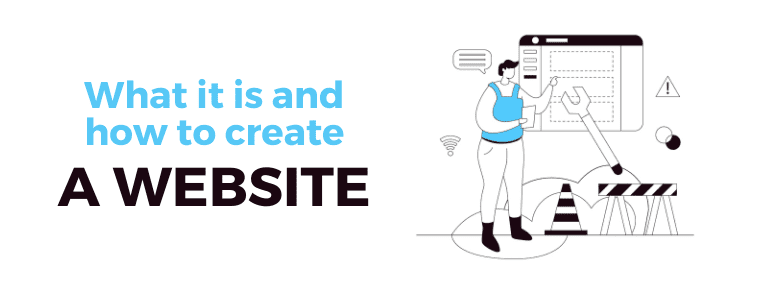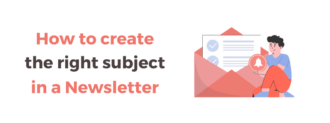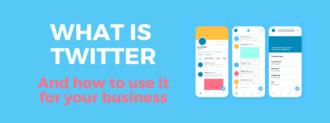Nowadays it’s odd if a professional or company doesn’t have a website. Or if they don’t want one. The same goes for all those people who want to talk about their hobbies, passions, etc: they usually have or would like to create a website. Because, who doesn’t want to take advantage of the window to the world that is the Internet? Yes, that’s right. But the first thing to do is to understand what a website is and secondly, consider how we can create one. And in this post, we explain everything.
Table of contents
What is a web page?
The definition of web page says that we call so to any digital document that contains audio, video or text elements (only one of each, several or all at once) that we can access when we connect via the Internet through our browser. In addition, any web page must comply with the standard rules of the World Wide Web, as does any other “media”.
Examples of web pages
The ones you see in the screenshot are examples of what is considered a web page. As you can see, there’s everything: Innovadeluxe’s service website, PrestaShop’s informational website, an IDX Engine website. And you can see how each one has its own style, design, colors, etc.

Although it seems simple, the truth is that many times the term website is used incorrectly and we are actually talking about a site instead of a page. We will talk about it in the next point.
What is a website?
The website is the set of web pages that compose it. Let’s say that the page is a street and the site is the neighborhood. The website encompasses all the web pages, as they all give different information on the same topic or related topics and maintain the look, design and brand colors.
For example, on our Innovadeluxe website there’s a home page, another web page about our SEO services, another page with the modules for PrestaShop, etc.

How to create a website
Before getting down to work, the first thing you have to do is to plan everything out and have a clear idea of what you want, because depending on this, you’ll decide on the sections in which you’re going to organize the project and even the design. So you can create a professional website in the eyes of those who visit you: well organized and functional, with good usability.
- First of all: What is the purpose of your website? What is it going to talk about? Will you dedicate a lot of time to it? Are you an expert on the subject or still learning? Are you creating a website as a hobby, for training or is it for a business?
- When you have everything clear, choose a domain name accordingly: a keyword related to the topic of the website, your professional or personal brand (your name, for example), etc.
- Depending on whether it is for a hobby or a business, the investment you want to make, etc, study which is the hosting that best suits your needs. It can be a very simple one or a more complete one, either way, pay close attention to what they offer you.
- Choose the platform for your site. There are many websites to create websites, but be careful because it’s not only about how pretty the design is. If it’s a business or in general a website that you want to position in Google, make sure you can have access to the back or “back end” of the page, so you can make the modifications you need to both, code and design, in case you want to customize it.
- And finally, depending on which platform you choose, you can have more or less templates, free or paid, to have a design that fits the theme or tone of your page.
Now that we’ve talked about the conceptual part, we’ll tell you the steps to create a website. Specifically, points 4 and 5 in more detail.
How to make a free website
Let’s talk about the Top 3 platforms that allow you to create a free website. Although in many cases you have the option to pay for some features or upgrade to a better service.
WordPress
The platform par excellence. But be careful, because you have to differentiate between wordpress.com and wordpress.org

WordPress.com is totally closed. Meaning that you create an account when registering and after that, the only thing you can do is upload content and at most, format the text in bold, italics and include links, but little else. So we don’t recommend it, since you can’t optimize anything at all if you want to work you SEO (which is quite important as we’ll mention several times throughout the article)
However, you can install WordPress.org on your computer and manipulate the code to change its appearance or improve its SEO. This type of WordPress is the one that is usually included when you sign up for hosting, so you really don’t even have to worry about installing anything. And when building up your website, you can use any of the thousands of free web templates out there.
Blogger
It’s Google’s platform, but curiously, it’s the one that offers less resources compared to WordPress, for example. If we look at the look & feel of their templates, it’s far behind.

If you’re looking for a stunning design, you have two ways to get it: either you download one of the Blogger templates that are on the Internet (which aren’t many) or you make it yourself from scratch. Because at least you can easily access the HTML and CSS code and add your own by clicking on the Customize and Edit HTML buttons.
WIX
It is within the group of platforms that create WYSIWYG (What you see is what you get) type web pages. That is, you enter the platform after registering and after choosing a template, you can modify it and go building the pages you want by simply dragging modules: the text, the carousel, the image, etc..

There are quite a few platforms like this, this is just a reference. As they are in principle free, the problem that many of them can have is that they fill your page with advertising – from which they’ll earn money, not you. So before you decide, create a couple of test pages, put them online and check if it’s going to be a banner festival or if, on the contrary, it’s not too intrusive.
One thing to keep in mind with these website builders, however – or at least in the case of WIX in particular – is that they’re also “closed source”. Which means that if you ever want to migrate your site to another site, you can’t access the code or download anything and you won’t be able to migrate the entire site: not the template or any premium add-ons. There’s going to be a lot of things you’ll have to start from scratch if you don’t find a similar template.
Designing your website
As we talked about before, the design of your website is very important. It gives it personality and builds trust if it’s a professional looking design. It happens to all of us that we enter a website, we see it very “crappy” or disorganized, and in the vast majority of cases, that causes to leave.
In the case of the design of your WordPress website, you can even choose the templates by theme: travel, fashion, news, etc.. So it’s as easy as looking at the catalog and choose the one that catches your attention.

Of course, in some cases they can be paid templates (although they aren’t expensive). And you’ll also have to know how to manage the structure of the template to replace the sections and contents that come by default and put your own, of course. And keep in mind: even if the information says that they’re optimized for SEO, this isn’t really the case. The good news is that there are many ways – one of them with plugins – to work SEO in WordPress, so there’s no problem.
If we talk about Blogger, as I mentioned in the previous point, its catalog of templates is quite poor because it focuses exclusively on blogs. In fact, that’s what it asks you as soon as you start, if you want to create a blog. And the first thing it offers you once you say yes, is to customize the title of your blog and indicate the terms you want to appear in the URL of the home. From this same screen you can also choose directly which template you want to use (and you can change it later for another one without having to do anything at all)
In any case, the thing about the Blogger design is that even the templates that have been created separately by developers are much better than the official ones that come by default. But there is still much less variety than in WordPress.
Otherwise, creating a website on Blogger is very easy: if you’ve already created a gmail account, it will recognize it and will ask you directly if you want to enter/register with that gmail. It’s that simple. Once inside, to work on SEO, you have an option in menu > settings > search engine preference. Here you can include for example the robots.txt file, which is very important when it comes to giving guidelines to Google. You can also do 301 redirects if you need to change the URL of a specific page, etc.

The good thing about blogger, is that by default it already does some of the most basic SEO functions, like setting canonicals automatically without you doing anything. And in each blog post you can customize the URL and add meta descriptions, just like in WordPress.
Finally, let’s talk about WIX. As soon as you sign up they give you the option to choose a template or they make it as easy as answering a few questions at the beginning and they automatically select the template that best suits what you want to achieve.
Then, you just have to click on the “Edit this site” button and access the inside of the web page, where you select the element you want and drag it to the place where you want to put it. They even have a tools section where they help you optimize the basics of SEO. They only ask you to answer 3 questions: name of your site, if it’s a local business or just online web, and to enter 5 keywords that define your business or web. With this info they create an “SEO Plan” and give you some steps you can follow to improve it. It’s not bad, but there are many things that are obviously not contemplated, such as the hierarchy of titles or that the links are follow or no follow, and many more.
Still, it’s a good platform to start tinkering with websites and marketing, because it guides you step by step in absolutely everything you have to do – within what you can do.
Both WordPress and WIX also offer templates for online shops. But be careful, because at Innovadeluxe we’ve been working with e-commerce for more than a decade and we can’t do anything else but give you this advice: if you really want to make an online shop that has prospects for growth, you must opt for a specific platform for e-commerce, because it’ll be the one that is best prepared and so, provide the best results. Especially if you have to “fight” against the competition, in which case, it’s important to work on SEO at all levels. Why would you want to create an e-commerce / website if no one is going to see it?
Conclusion
As you can see, understanding what a website is, is not difficult. Creating it is a lot more work. You have to think about what you need and how far you want to go to choose accordingly.
You also have to know how to differentiate between what it is to have an eye-catching and beautiful website, and a professional website. If it’s for a hobby, any of the three platforms will do. But if you want to take it to the next level, the most recommended option right now to create a website would be WordPress.
And of course, if you want to open an online store, I still say that it’s best to have a professional team behind it. Contact us if you have any questions!
Related Posts










Deja un comentario